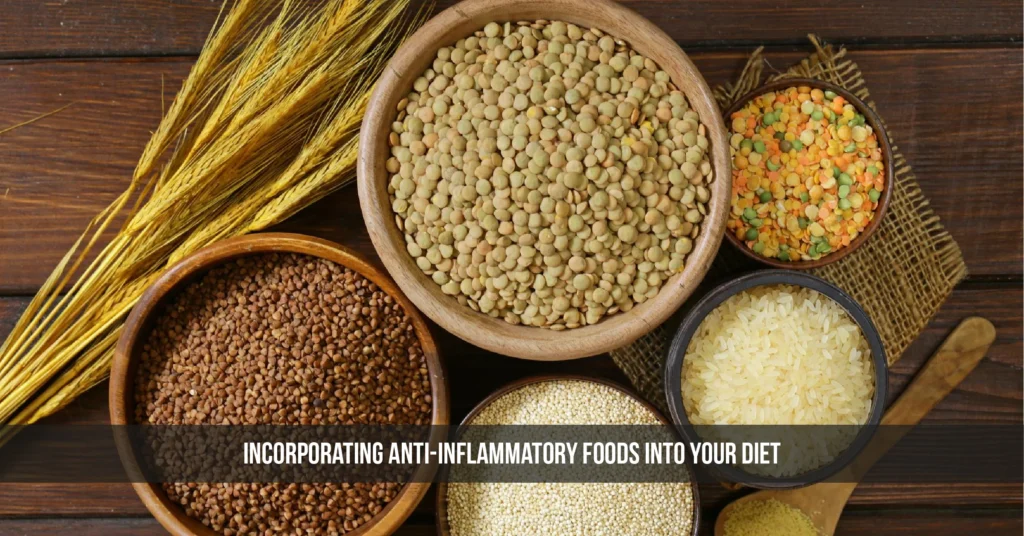Best Anti-Inflammatory Foods for Arthritis
Have you ever wondered if changing what you eat could ease joint pain and improve your quality of life? Millions of people live with arthritis, a condition that often brings persistent discomfort and limits daily activities. In this guide, we explore the best anti-inflammatory foods for arthritis and show how small changes in your diet can make a meaningful difference. From tasty fruits and vegetables to wholesome spices and legumes, this article explains why certain foods are celebrated for their benefits in reducing chronic inflammation and supporting joint health.
Table of Contents
Understanding Arthritis and Inflammation
What is Arthritis?
Arthritis is not a single disease but a collection of conditions that affect joints and the tissues around them. The following are some common forms:
- Osteoarthritis (OA):
This type is marked by the gradual wearing down of cartilage over time, leading to joint stiffness and pain. - Rheumatoid Arthritis (RA):
This is an autoimmune condition where the body’s defense system mistakenly attacks healthy joint tissues, resulting in swelling and pain. - Other Types:
There are over 100 different types of arthritis, each with its own set of symptoms and progression patterns, ranging from juvenile arthritis in children to gout in adults.
Understanding the variety of arthritis types can help determine the most effective ways to ease symptoms through diet and lifestyle modifications.
The Role of Inflammation
Inflammation is the body’s natural response to injury and infection. However, in cases such as arthritis, inflammation can persist longer than needed, leading to what many call chronic inflammation. This prolonged inflammatory response is harmful because:
- It damages cartilage and joint tissues.
- It triggers pain and stiffness that interfere with daily activities.
- It contributes to general feelings of fatigue and unwellness.
By focusing on foods that help regulate the inflammatory response, one can potentially mitigate some of the discomforts associated with arthritis. When inflammation runs unchecked, it can disrupt the balance of your entire body. That’s why understanding and managing inflammation is a key step in improving joint health.

The Science Behind Anti-Inflammatory Foods
Scientific research shows that certain nutrients possess properties that reduce inflammation in the body. Here are a few essential components:
- Omega-3 Fatty Acids:
Found naturally in fatty fish, these acids help calm the inflammatory response and support overall joint health. Studies have shown that diets rich in omega-3s can help lower inflammatory markers. - Antioxidants:
Compounds like vitamins C and E, found in many fruits and vegetables, help protect cells from damage caused by free radicals. Eating a variety of colorful produce not only provides antioxidants but also a range of beneficial phytochemicals. - Polyphenols and Phytochemicals:
These naturally occurring compounds in plants may help reduce inflammation through their interaction with various metabolic processes in the body.
Key Nutrients and Their Benefits
| Nutrient | Common Sources | Benefit |
|---|---|---|
| Omega-3 Fatty Acids | Salmon, mackerel, chia seeds | Reduce inflammatory markers and support joint function |
| Antioxidants | Berries, leafy greens, bell peppers | Combat oxidative stress and protect cell integrity |
| Polyphenols | Green tea, dark chocolate, grapes | Assist in lowering inflammation levels |
This table simplifies the essential nutrients that can contribute to a healthier, less inflamed system.

Top Anti-Inflammatory Foods for Arthritis
Incorporating a broad range of nutrient-rich foods into your diet can be both delicious and beneficial. Let’s review some top picks.
Fruits and Vegetables
When it comes to battling inflammation, colorful fruits and vegetables play a starring role. They are rich in antioxidants, vitamins, and fiber. Some favorites include:
- Blueberries:
These tiny fruits are power-packed with antioxidants which can help reduce oxidative stress. - Cherries:
Known for their deep red hue, cherries may ease joint pain and improve overall inflammation. - Leafy Greens (Spinach, Kale):
Loaded with vitamins A, C, and K, leafy greens support overall cell function and joint health. - Other Examples:
Think about adding bell peppers, broccoli, and tomatoes to your meals for a varied nutritional boost.
Healthy Fats and Omega-3 Sources
Fats are not always the enemy. The fats found in certain foods are very helpful when it comes to reducing inflammation:
- Fatty Fish:
Salmon and mackerel are great sources of omega-3 fatty acids. These help maintain cell membrane integrity and lower inflammation in the body. - Nuts and Seeds:
Incorporating walnuts, flaxseeds, and chia seeds into your diet provides a plant-based omega-3 boost. They also offer a satisfying crunch to your meals. - Avocado:
Rich in heart-healthy monounsaturated fats, avocados can contribute to lower inflammatory responses.
Spices and Herbs
Spices and herbs do more than enhance flavor; they pack potent anti-inflammatory benefits:
- Turmeric:
Contains curcumin, a compound celebrated for its anti-inflammatory benefits. It pairs well with black pepper to increase absorption. - Ginger:
Widely recognized for soothing digestive issues, ginger can also reduce markers of inflammation. - Garlic:
With its distinctive aroma, garlic offers anti-inflammatory and immune-boosting properties, which may help ease arthritis symptoms.
Whole Grains and Legumes
Switching to whole grains and legumes instead of refined carbohydrates can further decrease inflammation:
- Whole Grains:
Foods such as brown rice, quinoa, and oats provide fiber and essential nutrients that can help stabilize blood sugar levels and reduce inflammation. - Legumes:
Beans, lentils, and chickpeas are excellent sources of plant-based protein and fiber. They support a stable inflammatory response by helping to balance blood sugar.
Nuts and Seeds
Often recognized for their robust nutrient profile, these foods contribute to joint health and assist in inflammation control:
- Almonds:
Great for a quick snack or as a crunchy addition to various dishes, almonds provide vitamin E and other antioxidants. - Walnuts:
Particularly noted for their high omega-3 fatty acid content, walnuts are a smart choice for those looking to counter inflammation naturally. - Chia Seeds:
These tiny seeds add a nutritional punch to smoothies, yogurts, or baked goods. They offer fiber, protein, and omega-3 fatty acids in every serving.
Anti-Inflammatory Food Categories
| Food Category | Examples | Health Benefits |
|---|---|---|
| Fruits & Vegetables | Blueberries, cherries, leafy greens | Provide vitamins, antioxidants, and fiber |
| Healthy Fats & Omega-3 | Salmon, walnuts, avocado, chia seeds | Lower inflammatory markers and support joint health |
| Spices & Herbs | Turmeric, ginger, garlic | Contain bioactive compounds that reduce inflammation |
| Whole Grains & Legumes | Brown rice, quinoa, beans, lentils | Improve blood sugar levels and reduce chronic inflammation |
| Nuts & Seeds | Almonds, walnuts, chia seeds | Supply antioxidants and essential fatty acids |
This table outlines a variety of food categories, making it easier to understand the range of options available to anyone looking to manage arthritis symptoms naturally.
Incorporating Anti-Inflammatory Foods into Your Diet
Changing your diet can feel like a big step, but incorporating these foods gradually can be both fun and rewarding. Here are some ideas to guide you in making lasting adjustments.
Practical Meal Planning Tips
Adopting an anti-inflammatory diet is easier when you plan ahead. Here are a few tips to help turn healthy food choices into everyday habits:
- Start with Small Changes:
Swap refined grains for whole grains and introduce one new vegetable into your dinner menu each week. - Mix and Match:
Create meals that combine proteins, healthy fats, and a variety of vegetables. This balanced approach helps maintain stable energy levels. - Daily Reminders:
Leave yourself a note on the fridge with daily goals, like “Eat a serving of leafy greens with lunch” or “Snack on almonds instead of chips.” - Mindful Shopping:
Make a list before you hit the grocery store, focusing on whole foods and fresh ingredients rather than processed alternatives.
Recipes and Snack Ideas
Integrating anti-inflammatory foods into your daily routine can be as enjoyable as trying out new recipes or experimenting with vibrant ingredients. Consider the following suggestions:
- Breakfast:
Whip up a smoothie with spinach, blueberries, a spoon of chia seeds, and a splash of almond milk. Not only does it taste great, but it also provides a warm start to your day. - Lunch:
Enjoy a warm quinoa salad with chopped tomatoes, cucumbers, and avocado. Drizzle a light lemon-tahini dressing over it, and add some grilled salmon on the side. - Dinner:
Try a simple stir-fry featuring a variety of vegetables such as broccoli, bell peppers, and kale with a sprinkle of ginger and garlic for extra flavor. Include a serving of brown rice or whole-grain noodles to complete the dish. - Snacks:
Keep a mix of walnuts and fresh fruits handy, or enjoy a small bowl of Greek yogurt mixed with a handful of cherries. These snacks are filling, nutritious, and help keep your energy steady throughout the day.

Sample Daily Meal Plan Table
| Meal | Menu Suggestion |
|---|---|
| Breakfast | Spinach & blueberry smoothie with chia seeds and almond milk |
| Mid-Morning Snack | A handful of walnuts with a small apple |
| Lunch | Quinoa salad with avocado, tomatoes, cucumbers, and grilled salmon |
| Afternoon Snack | Greek yogurt mixed with cherries |
| Dinner | Stir-fry with broccoli, bell peppers, kale, ginger, garlic, served with brown rice |
This sample plan shows how to combine various anti-inflammatory foods in everyday meals effortlessly.
Conclusion
Integrating the best anti-inflammatory foods for arthritis into your daily meals can be a refreshing way to support joint health and overall well-being. Enjoy experimenting with vibrant fruits, vegetables, wholesome grains, and healthy fats as you create meals that are as delicious as they are nutritious. Remember, every small, enjoyable change in your diet can contribute to feeling better and more energetic.
Also Read: What is the Best Diet for Muscle Growth?
FAQs
Which foods should I avoid to reduce inflammation?
Avoid highly processed snacks, sugary treats, and foods high in saturated fats, as these can worsen inflammation. Opt for whole foods that naturally support healthy joints.
Can an anti-inflammatory diet really ease arthritis pain?
Many people experience reduced joint discomfort when they include anti-inflammatory foods in their meals. However, individual results vary, so consistency is key.
How soon can I notice improvements from dietary changes?
Changes might take a few weeks to a couple of months to become noticeable, depending on your current eating habits. Staying consistent with healthy choices is essential.
Are there supplements that work well with these foods?
Supplements like omega-3 fish oil or turmeric extract can complement your diet, but it’s wise to consult your healthcare provider before adding any new supplements.














Post Comment